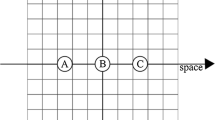Abstract
In modern physics, the constant “c” plays a twofold role. On the one hand, “c” is the well known velocity of light in an empty Minkowskian space–time, on the other hand “c” is a characteristic number of Special Relativity that governs the Lorentz transformation and its consequences for the measurements of space–time intervals. We ask for the interrelations between these two, at first sight different meanings of “c”. The conjecture that the value of “c” has any influence on the structure of space–time is based on the operational interpretation of Special Relativity, which uses light rays for measurements of space–time intervals. We do not follow this way of reasoning but replace it by a more realistic approach that allows to show that the structure of the Minkowskian space–time can be reconstructed already on the basis of a restricted classical ontology (Mittelstaedt, Philosophie der Physik und der Raum-Zeit, Mannheim: BI-Wissenschaftsverlag, 1988 and Mittelstaedt, Kaltblütig: Philosophie von einem rationalen Standpunkt, Stuttgart: S. Hirzel Verlag, pp. 221–240, 2003), and that without any reference to the propagation of light. However, the space–time obtained in this way contains still an unknown constant. We show that this constant agrees numerically with “c” but that it must conceptually clearly be distinguished from the velocity of light. Hence, we argue for a clear distinction between the two faces of “c” and for a dualism of space–time and matter.

Similar content being viewed by others
Notes
Mittelstaedt (2006).
Mittelstaedt (2008).
Except, of course of domains that are not considered in the present paper.
The first measurement of the velocity of light by O. Rømer was performed in 1670, several years before Newton’s “Principia” appeared in 1686 (1st ed.) and 1723 (2nd ed.).
Cf. for instance Gamov (1946).
Penrose (1959).
Terrell (1959).
For more details cf. Mittelstaedt (2006, p. 260).
“Hypotheses non fingo”, (Principia, 3. ed, p. 943).
For the role and importance of metaphysics in physical sciences cf. Vollmer (2007).
The original Latin formulation reads: “Tempus absolutum, verum et mathematicum, in se per natura sua absque relatione ad externum quodvis, aequabiliter fluit”.
We will not discuss here the reasons for the inadequacy of this axiomatic approach.
It is an important and difficult problem, how many test bodies must at least be used in the ensemble Γ in order to allow for deriving the linearity of the transformations between inertial systems. We will not discuss this question here and refer to the literature. Cf. Borchers and Hegerfeld (1972).
Mittelstaedt (1995, pp. 22–23).
For more details cf. Mittelstaedt (1995, pp. 92–95).
Mittelstaedt (1995), l.c.
Mittelstaedt (2006).
Hawking and Ellis (1973, p. 38).
References
Borchers, H. J., & Hegerfeld, G. C. (1972). Über ein Problem der Relativitätstheorie: Wann sind Punktabbildungen des Rn linear?. In Nachrichten der Akademie der Wissenschaften in Göttingen, II (pp. 205–229). Mathematisch-Physikalische Klasse, Nr.10.
Carr, B. (2007). Universe or multiverse?. Cambridge: Cambridge University Press.
Ellis, G. F. R. et al. (2003). Multiverse and physical cosmology. In arXiv: astro-ph/0305292v3.
Franck, Ph., & Rothe, H. (1911). Über die Transformation der Raum-Zeitkoordinaten von ruhenden auf bewegte Systeme. Annalen der Physik, 34, 825–855.
Gamov, G. (1946). Mr. Tompkins in wonderland. New York: The Macmillan Company.
Hawking, S. W., & Ellis, G. F. R. (1973). The large scale structure of space-time. Cambridge: Cambridge University Press.
Ignatowski, W. V. (1910). Einige allgemeine Bemerkungen zum Relativitätsprinzip. Physikalische Zeitschrift, 11, 972–976.
Lévy-Leblond, J. M. (1976). One more derivation of the Lorentz transformation. American Journal of Physics, 44, 271–277.
Linde, A. D. (1990). Inflation and quantum cosmology. San Diego, London: Academic Press.
Marzke, R. F., & Wheeler, J. A. (1964). Gravitation as geometry. I: The geometry of space-time and the geometrodynamical standard meter. In H.-Y. Chiu & W. F. Hoffman (Eds.), Gravitation and relativity (pp. 40–64). New York: W. A. Benjamin.
Misner, Ch. W., Thorne, K. S., & Wheeler, J. A. (1973). Gravitation. San Francisco: W. H. Freeman.
Mittelstaedt, P. (1976, 1989). Der Zeitbegriff in der Physik (3rd ed.). Mannheim: BI-Wissenschaftsverlag.
Mittelstaedt, P. (1988). Über die Bedeutung und Begründung der Speziellen Relativitätstheorie. In J. Audretsch & K. Mainzer (Eds.), Philosophie der Physik und der Raum-Zeit. Mannheim: BI-Wissenschaftsverlag.
Mittelstaedt, P. (1995). Klassische Mechanik (2nd ed.). Mannheim: Bilbliographisches Institut.
Mittelstaedt, P. (2003). Hätte Newton die Relativitätstheorie finden können? In W. Buschlinger & C. Lütge (Eds.), Kaltblütig: Philosophie von einem rationalen Standpunkt (pp. 221–240). Stuttgart: S. Hirzel Verlag.
Mittelstaedt, P. (2006). Intuitiveness and Truth in Modern Physics. In E. Carson & R. Huber (Eds.), Intuition and the axiomatic method (pp. 251–266). Dordrecht: Springer.
Mittelstaedt, P. (2008). Planck’s constant in the light of quantum logic. International Journal of Theoretical Physics, 47, 104–113.
Penrose, R. (1959). The apparent shape of a relativistically moving sphere. Proceedings of the Cambridge Philosophical Society, 55, 137–139.
Sexl, R. U., & Urbantke, H. K. (1992). Relativität, Gruppen, Teilchen (3rd ed.). Wien, New York: Springer.
Terrell, J. (1959). Invisibility of the Lorentz Contraction. Physical Review, 116, 1041–1045.
Vilenkin, A. (1982). Creation of universes from nothing. Physics Letters, 117B, 25–28.
Vollmer, G. (2007). Wie viel Metaphysik brauchen wir? In D. Westerkamp & A. von der Lühe (Eds.), Metaphysik und Moderne. Würzburg: Königshausen & Neumann.
Acknowledgments
It is a pleasure to thank Friedrich Hehl for useful criticisms and suggestions.
Author information
Authors and Affiliations
Corresponding author
Rights and permissions
About this article
Cite this article
Mittelstaedt, P. On the Meaning of the Constant “c” in Modern Physics. J Gen Philos Sci 41, 45–53 (2010). https://doi.org/10.1007/s10838-010-9114-0
Published:
Issue Date:
DOI: https://doi.org/10.1007/s10838-010-9114-0




